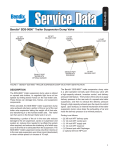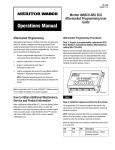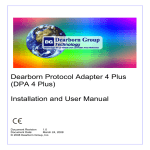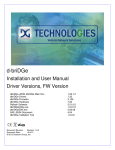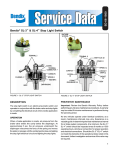Download BENDIX BW2710 User's Manual
Transcript
SD-03-4520 Bendix® SDS-9600™ Trailer Suspension Dump Valve 1/4" NPT RESERVOIR PORT 3/8" NPT DELIVERY PORT 1/4" NPT CONTROL PORT EXHAUST PORT SHOWN WITH DIAPHRAGM EXHAUST PORT SHOWN WITH OPTIONAL SILENCER 1/4" NPT SUPPLY PORT 3/8" NPT DELIVERY PORT FIGURE 1 - BENDIX® SDS-9600™ TRAILER SUSPENSION DUMP VALVE PORT IDENTIFICATION DESCRIPTION The SDS-9600™ trailer suspension dump valve is utilized to assist spread axle trailers, with air suspension, negotiate tight turns at low speeds by limiting torsion forces on the rear trailer axle. These forces can damage tires, frames, and suspension components. When activated, the SDS-9600™ trailer suspension dump valve exhausts (dumps) a portion of the air out of the rear trailer axle suspension taking the weight off of that axle, and transferring it to the forward trailer axle. The trailer can then pivot on the forward trailer axle in a turn. Maintaining a portion of the air in the rear axle reduces damage to the air suspension, saves on suspension and systems air, reduces time needed to re-inflate the system when required, and reduces tire chattering, all of which may occur if all of the air is exhausted from the suspension. The SDS-9600™ trailer suspension dump valve then returns air to the rear axle suspension upon driver input (deactivated) or when vehicle speed is in excess of 10 mph. The Bendix® SDS-9600™ trailer suspension dump valve is a pilot operated normally open three-way valve with a high-capacity exhaust, inversion control, and delivery pressure hold feature. The function of the valve is to apply delivery pressure to the rear axle of a spread axle trailer suspension, and then to exhaust the delivery pressure through a high-capacity exhaust upon the input of a control signal. Upon exhaust, an internal mechanism of the trailer suspension dump valve stops the exhausting of air and holds the delivery pressure at a minimal pressure. Porting is as follows: • • • • • (2) 3/8 inch NPT delivery ports (1) 1/4 inch NPT control port (1) 1/4 inch NPT supply port (1) 1/4 inch NPT reservoir (1) Exhaust port with Diaphragm or optional 3/8 inch NPT port 1 FRAME RAIL SPREAD AXLE TRAILER 2" MINIMUM CLEARANCE FRAME RAIL 2" MINIMUM CLEARANCE 3/8"-16 X .50 MOUNTING HOLES (2) EXHAUST 90° MAXIMUM 2" FIGURE 2 - MOUNTING THE SDS-9600™ TRAILER SUSPENSION DUMP VALVE OPERATION MOUNTING ORIENTATION The SDS-9600™ trailer suspension dump valve is mounted to the trailer frame rail or cross-member. It is preferred that the valve be mounted on the backside of a cross-member with the exhaust port facing down. Mounting on the top side of a cross-member is acceptable, provide the exhaust port is facing rearward on the vehicle. Never mount the valve with the exhaust port facing upwards. The valve should have at least 2 inches of clearance between the exhaust port and any other surface. Refer to Figure 2. PREVENTIVE MAINTENANCE Important: The SDS-9600™ control brake valve is not serviceable, but must be inspected for proper operation as a part of routine vehicle maintenance. No two vehicles operate under identical conditions, as a result, maintenance intervals may vary. Experience is a valuable guide in determining the best maintenance interval for air brake system components. At a minimum, the SDS-9600™ valve should be inspected every 6 months 2 or 1500 operating hours, whichever comes first, for proper operation. Should it not meet the elements of the operational tests noted in this document, further investigation and replacement of the valve may be required. REMOVAL Secure the vehicle with spring brakes or blocks. Drain the reservoir which supplies the SDS-9600™ valve. Mark and disconnect the connecting air lines. Remove the screws that secure the valve to the trailer frame rail. Remove the valve. INSTALLATION Typical system schematics for the SDS-9600™ valve are shown in Figures 3 and 4. Inspect the mounting hardware and replace if necessary. Check connecting air lines for integrity and foreign material, replace if necessary. Re-connect the air lines.. Check the operation of valve by charging system and performing the service check as described in this manual. TO AUXILIARY CONNECTOR RELAY ATC SOLENOID CONTROLLER PR-3™ PRESSURE PROTECTION VALVE (INTEGRATED CHECK VALVE) TRAILER SUSPENSION DUMP VALVE LEVELING VALVE FIGURE 3 - SYSTEM DIAGRAM – PRESSURE PROTECTION VALVE WITH INTEGRATED CHECK VALVE TO AUXILIARY CONNECTOR RELAY ATC SOLENOID CONTROLLER TRAILER SUSPENSION DUMP VALVE PR-4™ PRESSURE PROTECTION VALVE SINGLE CHECK VALVE LEVELING VALVE FIGURE 4 - SYSTEM DIAGRAM – PRESSURE PROTECTION VALVE WITHOUT INTEGRATED CHECK VALVE 3 SERVICE CHECKS LEAKAGE Build the air system to governor cutout. Shut off the engine. Using a soap solution, check all lines and fittings leading to and from the SDS-9600™ trailer suspension dump valve for leakage and integrity. Repair any excessive leaks - exceeding a 1" bubble in 5 seconds-before restoring vehicle to service. GENERAL The SDS-9600™ trailer dump system can be tested for full functionality by using Bendix® ACom™ Diagnostics Software. Bendix® ACom™ Diagnostics is a PC-based software program and is designed to meet RP-1210 industry standards. This software provides the technician with access to all the available ECU diagnostic information and configuration capability, including: • ECU information • Diagnostic trouble codes and repair information • Configuration (ABS, ATC, and more) • Wheel speed information • Perform component tests • Save and print information When using ACom™ Diagnostics software to diagnose the SDS-9600™ valve refer to the ACom™ I.O. Auxiliary, number 1, port. For more information on ACom™ Diagnostics software or RP1210 compliant tools, go to www.bendix.com or visit your local authorized Bendix parts outlet. WARNING! PLEASE READ AND FOLLOW THESE INSTRUCTIONS TO AVOID PERSONAL INJURY OR DEATH: When working on or around a vehicle, the following general precautions should be observed at all times. 1. Park the vehicle on a level surface, apply the parking brakes, and always block the wheels. Always wear safety glasses. 2. Stop the engine and remove ignition key when working under or around the vehicle. When working in the engine compartment, the engine should be shut off and the ignition key should be removed. Where circumstances require that the engine be in operation, EXTREME CAUTION should be used to prevent personal injury resulting from contact with moving, rotating, leaking, heated or electrically charged components. 4 3. Do not attempt to install, remove, disassemble or assemble a component until you have read and thoroughly understand the recommended procedures. Use only the proper tools and observe all precautions pertaining to use of those tools. 4. If the work is being performed on the vehicle’s air brake system, or any auxiliary pressurized air systems, make certain to drain the air pressure from all reservoirs before beginning ANY work on the vehicle. If the vehicle is equipped with an AD-IS® air dryer system or a dryer reservoir module, be sure to drain the purge reservoir. 5. Following the vehicle manufacturer’s recommended procedures, deactivate the electrical system in a manner that safely removes all electrical power from the vehicle. 6. Never exceed manufacturer’s recommended pressures. 7. Never connect or disconnect a hose or line containing pressure; it may whip. Never remove a component or plug unless you are certain all system pressure has been depleted. 8. Use only genuine Bendix ® replacement parts, components and kits. Replacement hardware, tubing, hose, fittings, etc. must be of equivalent size, type and strength as original equipment and be designed specifically for such applications and systems. 9. Components with stripped threads or damaged parts should be replaced rather than repaired. Do not attempt repairs requiring machining or welding unless specifically stated and approved by the vehicle and component manufacturer. 10. Prior to returning the vehicle to service, make certain all components and systems are restored to their proper operating condition. 11.For vehicles with Antilock Traction Control (ATC), the ATC function must be disabled (ATC indicator lamp should be ON) prior to performing any vehicle maintenance where one or more wheels on a drive axle are lifted off the ground and moving. BW2710 © 2008 Bendix Commercial Vehicle Systems LLC. All rights reserved. 5/2008 Printed in U.S.A. 5





